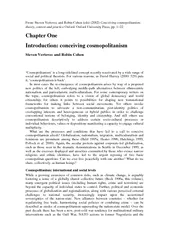PDF-From Steven Vertovec and Robin Cohen eds Conceiving c
Author : marina-yarberry | Published Date : 2015-05-19
1 22 Chapter One Introduction conceiving cosmopolitanism Steven Vertovec and Robin Cohen Cosmopolitanism is a longsidelined concept recently reactivated by a wide
Presentation Embed Code
Download Presentation
Download Presentation The PPT/PDF document "From Steven Vertovec and Robin Cohen eds..." is the property of its rightful owner. Permission is granted to download and print the materials on this website for personal, non-commercial use only, and to display it on your personal computer provided you do not modify the materials and that you retain all copyright notices contained in the materials. By downloading content from our website, you accept the terms of this agreement.
From Steven Vertovec and Robin Cohen eds Conceiving c: Transcript
Download Rules Of Document
"From Steven Vertovec and Robin Cohen eds Conceiving c"The content belongs to its owner. You may download and print it for personal use, without modification, and keep all copyright notices. By downloading, you agree to these terms.
Related Documents














